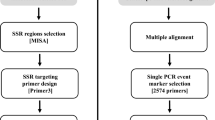Abstract
The incorporation of heteroduplex analysis into conventional strategies for the study of polymorphisms at microsatellite loci has allowed us to obtain information useful in determining genetic diversity and relationships among organisms. We have chosen, as a model for the testing of this strategy, several Solanum tuberosum varieties cultivated on Tenerife Island (Canary Archipelago) and a (TCT)n microsatellite located in intron I from the gene for granule-bound starch synthase. The data obtained confirm the high degree of agreement between molecular and farmer taxonomy.
Similar content being viewed by others
Author information
Authors and Affiliations
Additional information
Received: 21 September 1998 / Accepted: 28 December 1998
Rights and permissions
About this article
Cite this article
Pérez, J., Maca, N. & Larruga, J. Expanding informativeness of microsatellite motifs through the analysis of heteroduplexes: a case applied to Solanum tuberosum. Theor Appl Genet 99, 481–486 (1999). https://doi.org/10.1007/s001220051260
Issue Date:
DOI: https://doi.org/10.1007/s001220051260




